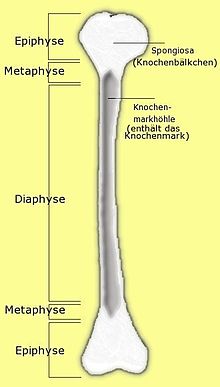Bone
![]()
The title of this article is ambiguous. For other meanings, see Bone (disambiguation).
The bone (Latin Os, plural Ossa, Greek οστούν in compounds Osteo-; German also Bein, from Germanic word root, compare Brustbein, Elfenbein, Beinhaus and English bone) is an organ resistant to pressure and tension. Bones make up the endoskeletons of vertebrates. The human skeleton of an adult consists of about 205 bones. The number varies because there may be different numbers of small bones in the foot and spine. Small bones, for example accessory bones in the carpus or tarsus, are often called ossicles (knuckles).
Bones are part of the musculoskeletal system and are classified as part of the passive musculoskeletal system. The individual bones look different depending on their position and function. At the same time, the bones protect internal organs, such as the bones of the skull protect the brain and the rib cage protects the heart and lungs. In addition, red blood cells, platelets and white blood cells are formed in the red bone marrow. The size varies between the only millimeter-sized ossicles of some small mammals to the meter-long leg and rib bones of dinosaurs.

Human skeleton (front view)
Etymology
Originally, parts of the endoskeleton were called leg (mhd., ahd. bein; plural: Beine, collective noun: Gebein), since the 14th century with the bone derived from knoche (mhd.) or knoke (mnd.). The probably originally onomatopoeic word (cf. knacken, English to crack) largely displaced the older leg. In the German names of some bones, however, the word Bein still occurs, for example in almost all skull bones. Cf. also ivory.
Bone Shapes
Osteology as a branch of anatomy distinguishes between different bone forms:
- Tubular bones (long bones, ossa longa): upper arm bone (humerus), ulna (ulna) and radius (radius), thigh bone (femur) and tibia (tibia), fibula (fibula) and phalanges. The long bones consist of two bone ends (epiphysis) and a bone shaft (diaphysis).
- flat bones (ossa plana): on the skull (cranium) and as ribs (costae), scapula, sternum, pelvis (ossa coxae)
- short bones (ossa brevia): unshaped bones, such as carpal bones
- sesamoid bones (ossa sesamoidea): small roundish bones embedded in tendons, which can occur variably, such as the kneecap (patella)
- air-filled bones (ossa pneumatica): contain cavities filled with mucous membrane, on the skull the frontal bone (Os frontale)
- irregular bones (ossa irregularia): they cannot be assigned to the other bone forms, vertebrae (vertebrae) of the spinal column or the lower jaw bone (mandible).

Schematic structure of a long bone
Questions and Answers
Q: What are bones?
A: Bones are parts of the skeleton of vertebrates that also protect organs inside the body.
Q: What is the significance of bones?
A: Bones are the framework of the body that allow us to move and also protect our vital organs.
Q: How do bones protect us?
A: The skull protects the brain, ribs protect the heart and lungs, the jaw and skull support the facial muscles, the pelvis protects reproductive organs, and vertebrae protect the spinal cord.
Q: Is bone a living tissue?
A: Yes, bone is a living tissue that requires maintenance through regular exercise and the consumption of calcium-rich foods such as milk and dark leafy greens like spinach.
Q: What is the function of bone marrow?
A: The bone marrow in the middle of the bigger bones makes our red blood cells.
Q: How important is calcium in bone health?
A: Calcium is important for maintaining bone health as it helps to keep bones strong.
Q: Can bones function without calcium?
A: No, bones require calcium to maintain their strength and function properly.
Search within the encyclopedia